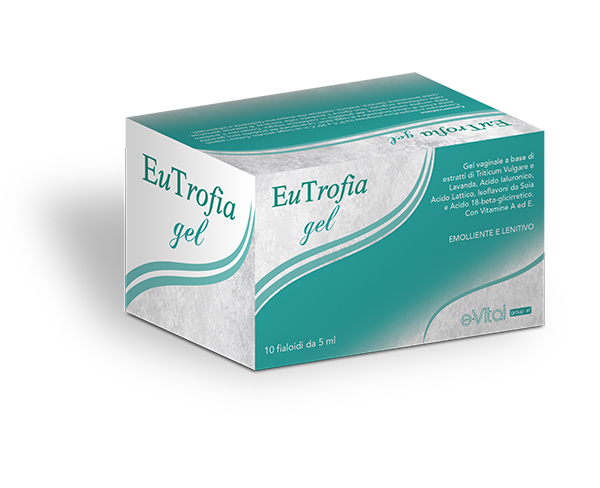EuTrofia gel
- How to use
Initial treatment: one dose of vaginal gel applicator per day for 3 weeks (before to going to bed). Maintenance treatment: one dose of vaginal gel applicator twice a week for the duration indicated by the medical prescription.


- Risk factors
Main causes of Vaginal Atrophy:
- Hypoestrogenism (physiological or iatrogenic menopause, primary and secondary amenorrhea, chronic anovulation, postpartum and lactation)
- Therapies (hormonal contraception, pessaries, IUD, antibiotic therapy, chemotherapy, radiotherapy)
- Endocrine and autoimmune disorders (diabetes mellitus, Sjogren’s syndrome, lichen sclerosus)
- Alterations of the vaginal microbiota (recurrent vaginal infections)
- Hypersensitivity to detergents or synthetic fabrics
- Active ingredients
EuTrofia gel contains 5 ml of vaginal gel that contains Aqueous extract of Triticum Vulgare and Lavander, Hyaluronic Acid, Lactic Acid,
Soy Isoflavones and 18-beta-glycyrrhetic Acid. With Vitamin A and E.
- Why EuTrofia gel?
EuTrofia gel is ideal for alleviating the feeling of dryness and vulvovaginal irritation caused by the decrease in the elasticity of the genital area in all stages of a woman’s sexual life, by favoring the right hydrolipid balance of the mucosa, carrying out an emollient and soothing action without altering the natural microbial flora and without any risk of toxicity, neither immediate nor delayed. EuTrofia gel is particularly indicated for the prevention and treatment of menopausal genitourinary dystrophy.
The vulvo-vaginal atrophy (VulvoVaginal Atrophy, VVA), that is the involution of the architecture of the vaginal and vulvar tissues, due to the lack of sex hormones (estrogen and testosterone) after menopause, is the main cause of dryness for the woman ; the clinical picture also involves the bladder and the urethra therefore we speak of genitourinary syndrome of the menopause (Genitourinary Syndrome of the Menopause, GSM).
Vaginal dryness is rarely an isolated symptom: the thinned vaginal mucosa, in fact, easily meets spontaneous microabrasions with an increased risk of infections; at the urethral level the mucosa becomes thinner and undergoes incontinence, becomes more easily inflamed after the sexual relations with consequent urinary burning up to the manifestation of cystitis due to the increased vulnerability to pathogenic biofilms, especially from Escherichia Coli, extracellular in vagina and intracellular in the urothelium.
To prevent or treat dryness and vaginal atrophy, local hormone therapy can be indicated especially with the occurrence of menopause; however, for women who cannot use estrogen (operated for breast, ovarian or uterine cancer), vaginal hyaluronic acid can be used, it has a reparative and antioxidant action. Hyaluronic acid is an essential component of the tissues, as well as of the film of glucosaminoglycans in which the vaginal lactobacilli live and helps to improve not only the lubrication but also the natural reconstitution of the vaginal habitat, assisting also in the case of therapy for bacterial vaginosis. EuTrofia gel creates a protective film for the mucous membranes able to counteract vaginal dryness and to facilitate the restoration of vaginal tissue tropism and the normal physiological functions of the vaginal mucosa, giving hydration, elasticity and vaginal comfort.
EuTrofia gel also finds effective application in facilitating the epithelial repair process after treatment of benign gynecological lesions.

- Bibliography
- Cagnacci A, Xholli A, Sclauzero M, Venier M, Palma F, Gambacciani M; writing group of the ANGEL study. Vaginal atrophy across the menopausal age: results from the ANGEL study. Climacteric. 2019 Feb;22(1):85-89. doi: 10.1080/13697137.2018.1529748
- Kling JM, Faubion SS. Genitourinary syndrome of menopause: in their own words-development of a new patient-reported outcome measure. Menopause. 2019 Feb 4. [Epub ahead of print]
- Mitchell CM, Waetjen LE. Genitourinary Changes with Aging. Obstet Gynecol Clin North Am. 2018 Dec;45(4):737-750. doi: 10.1016/j.ogc.2018.07.010. Epub 2018 Oct 25. Review
- Genitourinary syndrome of menopause: new terminology for vulvovaginal atrophy from the International Society for the Study of Women’s Sexual Health and the North American Menopause Society. Vulvovaginal Atrophy Terminology Consensus Conference Panel Maturitas. 2014 Nov; 79 (3): 349-54
- Sturdee DW, Panay N. International Menopause Society Writing Group. Recommendations for the management of postmenopausal vaginal atrophy. Climacteric 2010; 13: 509-522
- Chen J, Geng L, Song X, Li H, Giordan N, Liao Q. Evaluation of the efficacy and safety of hyaluronic acid vaginal gel to ease vaginal dryness: a multicenter, randomized, controlled, open-label, parallel-group, clinical trial. J Sex Med. 2013 Jun;10(6):1575-84
- Karaosmanoglu O, Cogendez E, Sozen H, Asoglu MR, Akdemir Y, Eren S. . Hyaluronic acid in the treatment of postmenopausal women with atrophic vaginitis. Int J Gynaecol Obstet. 2011 May;113(2):156-7. doi: 10.1016/j.ijgo.2010.12.007. Epub 2011 Mar 21
- Sanguigno L1, Minale M2, Vannini E2, Arato G2, Riccio R2, Casapullo A3, Monti MC3, Riccio R3, Formisano S1, Di Renzo G4, Cuomo O5.Oligosaccharidic fractions derived from Triticum vulgare extract accelerate tissutal repairing processes in in vitro and in vivo models of skin lesions. J Ethnopharmacol. 2015 Jan 15;159:198-208. doi: 10.1016/j.jep.2014.10.051. Epub 2014 Nov 8
